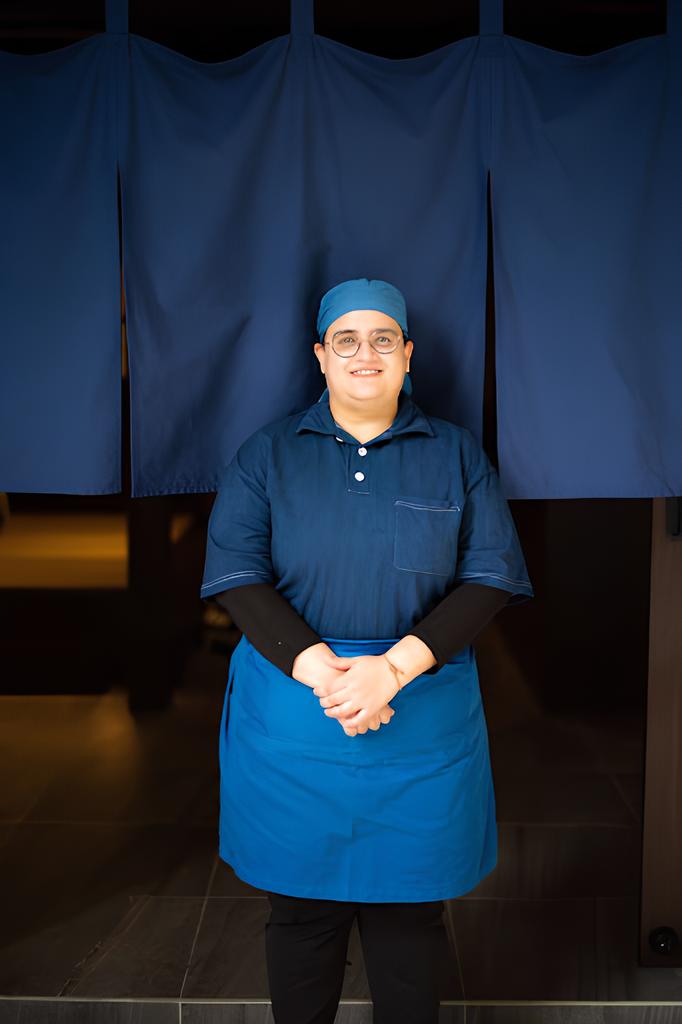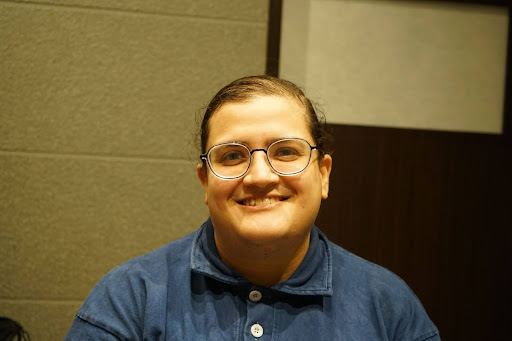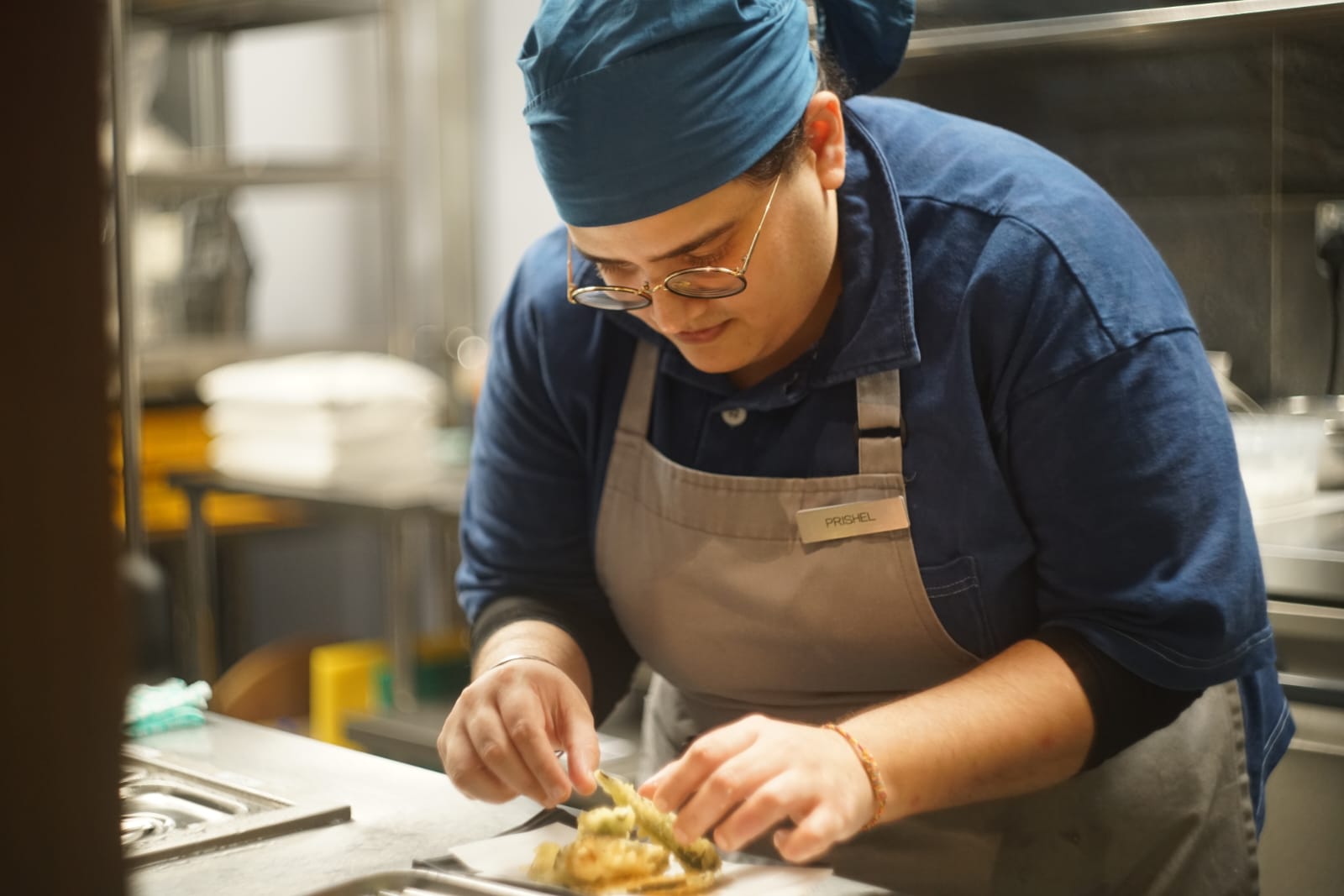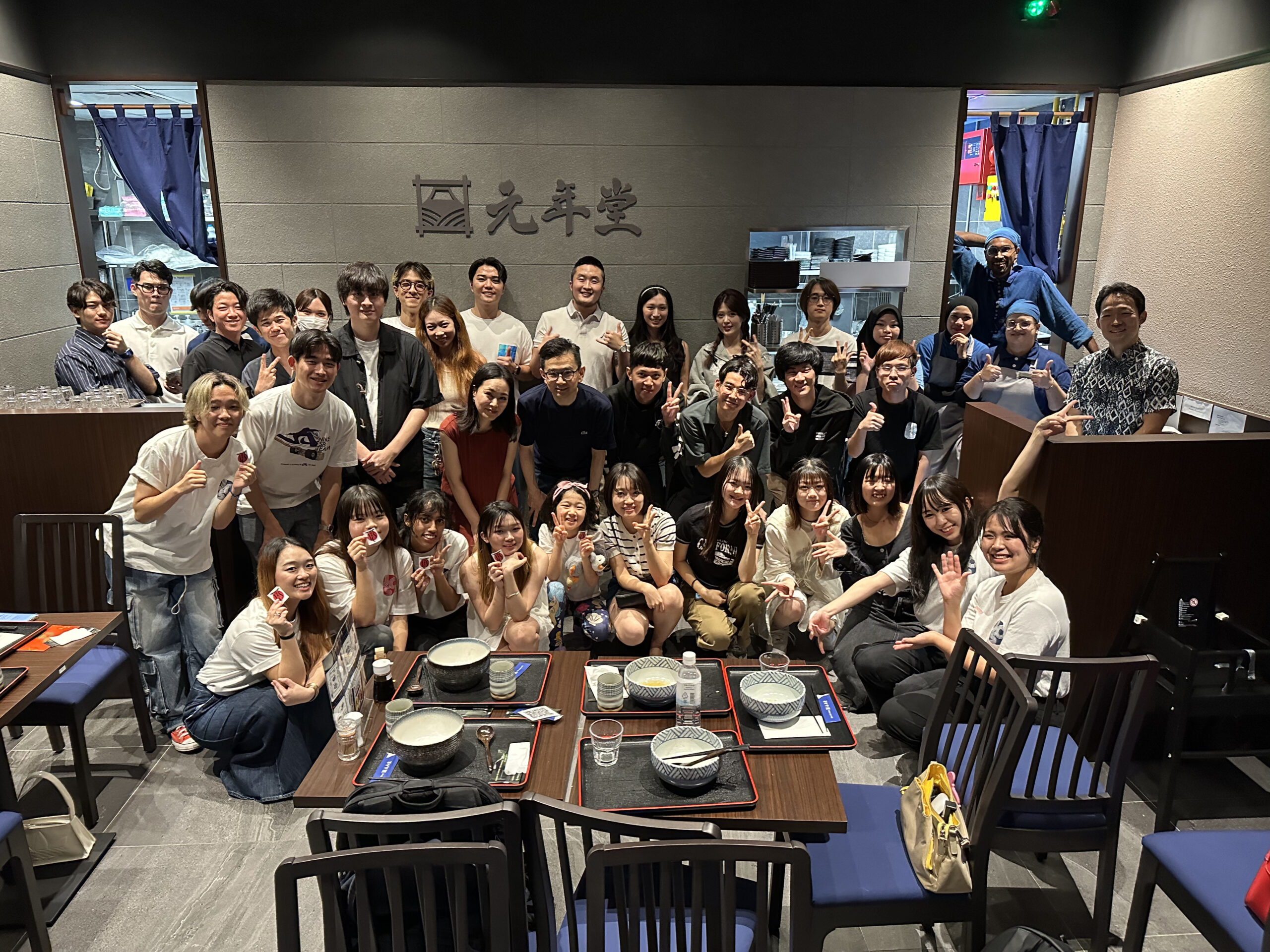「十割そばで伝える日本の心」——文化と味の架け橋
【元年堂シェフ】 プリシェル 氏
マレーシア・クアラルンプールで十割そばを提供しながら日本文化の企画展示会スペースを備える店舗「元年堂(がんねんどう)」。
静岡の十割そば屋「元年堂」の海外一店舗目として2024年9月にオープン。日本企業やローカルの人々とのコラボレーションイベントなどを多数行い、リピーターを増やしながら『ここでしか味わえない日本の「体験」と「感性」』を発信しています。
今回は、元年堂マレーシア店のシェフとして厨房を支えるプリシェルさんにインタビューを行いました。彼女が日本食の魅力に惹かれ本格的な十割そば作りに打ち込む背景、JALと連携し大成功を収めた年越しそばイベント、そして今後のビジョンについて伺いました。

Culture Link Malaysia. Sdn.Bhd
元年堂の運営母体。マレーシア・クアラルンプールで十割そばを提供する元年堂を運営しつつ、日本企業やアーティストなど日本文化、日本の作品を展示する“ギャラリースペース”を併設。海外進出支援やテストマーケティングのサポートを行っている。
▼元年堂マレーシアクアラルンプール
HPはこちら
Instagramはこちら
TikTokはこちら
登場人物
プリシェル(Prishel)
日本食歴9年のそば職人で、元年堂マレーシア店のシェフを務める。
前職のそば店で日本料理に目覚め、十割そばの技術習得に打ち込む。
JALや大学と連携した年越しそばイベントを成功させ、日本文化の発信にも尽力し、将来は自分のそば店と製造工場を持ち、BtoBの事業や航空会社への機内食展開なども目指している。

日本料理を通じて、その背景にある物語や文化を伝えたい
— まずは自己紹介をお願いします。
プリシェル:
元年堂のシェフのプリシェルです。日本食業界で働き始めて、9年目になります。元年堂で働く前は、クアラルンプールの別のそば店で8年間働いていました。当時はそばはおろか、日本料理全般についての知識も全くない状態からスタートしましたが、働き始めたことをきっかけに日本食への深い情熱が芽生えました。
そばを作る技術や天ぷらの揚げ方、日本の文化そのものを学ぶことが楽しくて、どんどんのめり込んでいきました。日本食には、それぞれの料理にストーリーがあり、私は料理を通じてそのストーリーをお客さんに伝えたいと思っています。ただ「お腹を満たすための食事」ではなく、食べることで何かを感じてもらえるような料理を提供したいんです。
— そば作りに興味を持ったきっかけは何でしたか?
プリシェル:
そばの技術に興味を持つようになったのは、前職のそば店での経験がきっかけです。最初は調理補助として業務に携わっていましたが、日々の業務を通して「自分自身の手で本格的なそばを作りたい」という思いが芽生え、「いつか独立してそば店を開きたい」という夢を抱くようになりました。その夢を実現するためにはそば作りの技術を極める必要があると考え、元年堂で働き始めてから本格的にそば打ちの技術や調理技術を習得しました。当初は慣れないこともありましたが、現在は自信を持ってそばを提供できるようになりました。
— 初めてそばを食べたときの印象を覚えていますか?
プリシェル:
最初にそばを見たときは、「これはどうやって食べるんだろう?」と思いました。ただ麺をつゆにつけて食べるだけのシンプルな料理に見えたんです。でも、実際に食べてみると、驚くほど奥深い味わいがありました。
特にそばは、さまざまな食材と組み合わせることで味や風味が変化するところが面白いです。温かいそばと冷たいそばでも違いますし、トッピングの種類によっても印象が変わります。その奥深さに魅力を感じるようになりました。

— マレーシア料理と日本料理の違いについて教えてください。
プリシェル:
マレーシア料理は多様な食文化が融合した「ミックスカルチャー」である点が大きな特徴です。中華料理やタイ料理からの影響が見られ、一般的にスパイスや調味料を多用する傾向があります。一方、日本料理は比較的シンプルな味付けを特徴とし、素材本来の風味を最大限に引き出すことを重視しています。
—対照的ですね。マレーシアにおいて、日本食の人気はどう変化しているのでしょうか?
プリシェル:
一昔前までは、日本食に馴染みのある人は少なかったと思います。特に、本格的なそばを知っている人はほとんどいませんでした。しかし、最近では日本食が一般的になり、寿司やラーメン以外の料理にも興味を持つ人が増えてきていると感じます。
そばに関して言うと、冷たいそばを食べる文化はまだ完全に定着しているとは言えません。(マレーシア人は温かい食事を好む傾向があるため)冷たいそばを食べることに慣れていない人も多く、最初は戸惑う方が多いですが、2、3回食べるとその美味しさに気づいてくれる方が多いです。
— 日本のそばには二八そばや十割そばがありますが、その違いについてどう思いますか?
プリシェル:
私は、十割そばの方が好きです。100%そば粉だけで作られているので、香りが強く、ナッツのような風味を楽しめます。二八そばは小麦粉が入っているので、食感が滑らかですが、そば本来の風味が楽しめる十割そばに魅力を感じています。
— 日本人と働く上で、苦労したことはありますか?
プリシェル:
一番大変だったのは、言葉の壁です。特に働き始めた当初、私の上司は英語が話せなかったためコミュニケーション手段はGoogle翻訳に頼らざるを得ませんでした。そのため、意図が正確に伝わらず、誤解が生じることもありました。
ー文化的な違いを感じる場面はありましたか?
プリシェル:
規律正しく、細部まで徹底的にこだわる日本人の仕事への姿勢には、日々感銘を受けています。また、誤解を生まないようにはっきりと伝えてくれるので、仕事がしやすいです。
元年堂×JAL×現地大学の三者共同企画で実現した年越しそばイベント
ー2024年の年末にプリシェルさんがシェフとして企画・運営された年越しそばイベントについて教えてください。
プリシェル:
「年越しそば」をテーマに日本文化を体験できるイベントを、JALクアラルンプール支店、テイラーズ大学の学生団体と連携して元年堂で開催しました。
前半に年越しそばの背景や日本の文化を学ぶトークセッション、後半にそば打ち体験と実食がセットになった二部構成のイベントです。当日は約50名のお客様にご参加いただき、私は年越しそばやその食材の説明と天ぷらの調理を担当しました。
天ぷらはお客様に好きな食材を選んでいただき、その場で揚げて提供したのですが、皆様楽しんで召し上がってくださいました。お客様が料理を心から楽しんでいる様子を目の当たりにし、とても嬉しい瞬間でした。


ーイベントに向けてどのような準備をされたのでしょうか?
プリシェル:
イベントに向けて、年越しそばの食材の意味や歴史について集中的に勉強しました。例えば、エビは長寿の象徴、わかめは豊かな自然を表すとされています。私は、食材の背景にある物語を知ることで、料理がもっと美味しく、楽しくなると信じています。お客様にもそれを感じていただきたかったので、食材の由来や意味を詳しく説明できるよう、一ヶ月前から準備を重ねました。
— お客様の反応はいかがでしたか?
プリシェル:
「そばはとても美味しく、日本文化も体験できて面白かった」「来年も楽しみにしている」といった温かいお言葉を多くいただきました。イベント前は不安もありましたが、95%という高い割合でポジティブなフィードバックをいただけたことは、大きな誇りであり、達成感に繋がりました。
今後の目標とメッセージ
— 最後に、今後の目標を教えてください。
プリシェル:
日本の伝統的なそばの味を、そのままマレーシアの人々に届けたいです。
そばを通じて、日本の文化や食の魅力を伝えられる存在になりたいと思っています。
そのため将来的には、自分のそば店を持ちたいと考えています。そばの製造工場を作り、十割そばを様々なレストランに卸すBtoBの事業にもチャレンジしたいですし、航空会社の機内食としてそばを提供することも、私の大きな目標の一つです。
— これからマレーシアでビジネスを始める方々に向けたメッセージをお願いします。
プリシェル:
常に謙虚であること、正直であること、ビジネスの冒険を楽しむことが大切だと思います。多くの人がビジネスを始めると、傲慢になり、ルーツを忘れてしまいます。私は常に謙虚でありたいと思っています。CEOであろうと、どんな立場であろうと、常に謙虚に、すべての人を平等に扱うことが大切です。
海外進出をご検討されているものの、具体的な進め方が不明確なお客様へ。
弊社では、マレーシアにてそば店運営とテストマーケティングが可能な企画展示会スペースを運営しており、会計やマーケティング、店舗開発のスペシャリストを集めた専門チームがお客様の課題解決を支援いたします。
👉 「マレーシア進出を成功させるための無料相談はこちらから!」(問い合わせフォームへリンク)
“The Art of Soba: Chef Prishel’s Challenge to Introduce Japan’s Flavors and Traditions”
Gan-Nen-Do is a store in Kuala Lumpur, Malaysia that serves Juwari Soba and also has a space for special exhibitions on Japanese culture. Opening in September 2024 as the first overseas store of Shizuoka’s Juwari Soba restaurant “Gennendo”. We hold many collaborative events with Japanese companies and local people, and while increasing the number of repeat customers, we are promoting “Japanese “experiences” and “sensibilities” that can only be experienced here.
This time,Supporting the kitchen as a chef at Gennendo Malaysia branchPrishellWe interviewed Mr. We asked her about the background behind her fascination with Japanese food and her dedication to making authentic Juwari soba, the hugely successful New Year’s Eve soba event she collaborated with JAL, and her vision for the future.
Characters
Prishel
Prishel is a soba chef with 9 years of experience in Japanese cuisine and currently works as the head chef at Gan-Nen-Do in Malaysia.
She discovered her passion for Japanese cuisine while working at a previous soba restaurant, where she dedicated herself to mastering the art of making juwari soba (100% buckwheat noodles).
She successfully held a New Year’s Eve soba event in collaboration with Japan Airlines (JAL) and a university, and is deeply committed to promoting Japanese culture. In the future, she hopes to open her own soba restaurant and manufacturing facility, with the goal of expanding into B2B services and developing in-flight meals for airline companies.

I want to convey the stories and culture through Japanese dishes.
— First of all, please introduce yourself.
Prishell:
I’m Prishel, the chef at Gennendo. It’s been nine years since I started working in the Japanese food industry. Before working at Gennendo, I used to work at another soba restaurant in Kuala Lumpur for eight years. At that timeI started with no knowledge of Japanese cuisine in general, let alone soba, but once I started working there, I developed a deep passion for Japanese food.
I enjoyed learning about the techniques of making tempura, how to fry tempura, and Japanese culture itself, and I became more and more absorbed in it. In Japanese food, each dish has a story, and I want to tell that story to our customers through our food. We don’t just want to serve food to fill your stomach, we want to provide food that makes you feel something when you eat it.
— What made you interested in making soba?
Prishell:
My interest in soba techniques stemmed from my experience at my previous job at a soba restaurant. At first, I worked as a cooking assistant, but through my daily work, I developed a desire to make authentic soba noodles with my own hands, and began to dream of opening my own soba restaurant one day. In order to make that dream come true, I thought it was necessary to master soba making techniques, so when I started working at Gennendo, I seriously learned the techniques of soba making and cooking. At first, I didn’t get used to it, but now I can serve soba with confidence.
— Do you remember your impressions when you ate soba for the first time?
Prishell:
When I first saw soba, I thought, “How do I eat this?” It seemed like a simple dish, just dipping noodles in soup and eating. However, when I actually tried it, I was surprised at how deep the flavor was.
Soba in particular is interesting in that its taste and flavor change by combining it with various ingredients. There is a difference between hot and cold soba, and the impression changes depending on the type of toppings. I began to feel fascinated by its depth.

— Please tell me about the differences between Malaysian cuisine and Japanese cuisine.
Prishell:
A major feature of Malaysian cuisine is that it is a “mixed culture” that combines diverse food cultures. It shows influences from Chinese and Thai cuisine, and generally tends to use a lot of spices and seasonings. On the other hand, Japanese cuisine is characterized by relatively simple seasoning and focuses on bringing out the original flavor of the ingredients to the fullest.
—It’s quite a contrast. How is the popularity of Japanese food changing in Malaysia?
Prishell:
Until a few years ago, I don’t think there were many people who were familiar with Japanese food. In particular, very few people knew about authentic soba. However, recently Japanese food has become popular, more and more people are becoming interested in cuisines other than sushi and ramen. I feel that.
When it comes to soba, the culture of eating cold soba is not yet fully established. (Malaysians tend to prefer hot meals) many people are not used to eating cold soba and are confused at first, but after eating it a few times they realize how delicious it is.
— There are two types of soba in Japan, Nihachi soba and Juwari soba. What do you think about the differences between them?
Prishell:
I prefer Juwari Soba. It’s made with 100% buckwheat flour, so it has a strong aroma and a nutty flavor. Nihachi soba contains wheat flour, so it has a smooth texture, but I like the Jyuwari soba, which allows you to enjoy the original flavor of soba.
— Have you ever had any difficulties working with Japanese people?
Prishell:
The most difficult thing was the language barrier. Especially when I first started working, my boss didn’t speak English, so we had no choice but to rely on Google Translate as a means of communication. As a result, our intentions could not be conveyed accurately, leading to misunderstandings.
—Did you ever feel any cultural differences?
Prishell:
I am constantly impressed by the Japanese people’s disciplined and meticulous approach to work. Also, it is easy to work with them because they clearly communicate information to avoid any misunderstandings.
“Gan-Nen-Do, JAL, and Taylor’s University Collaborated for Toshikoshi Soba Event”
— Please tell me about the Toshikoshi soba event.
Prishell:
An event where you can experience Japanese culture with the theme of “Toshikoshi Soba” was held at Gennendo in collaboration with the JAL Kuala Lumpur branch and Taylor’s University student group.
This is a two-part event, with the first half being a talk session to learn about the background of Toshikoshi soba and Japanese culture, and the second half being a soba making experience and tasting. On that day approximately 50 customers participated. I was in charge of explaining Toshikoshi soba and its ingredients, and cooking tempura. For the tempura, we asked the customers to choose their favorite ingredients and fried it on the spot, and everyone enjoyed it. It was a very gratifying moment to see the customers truly enjoying the food.


— How did you prepare for the event?
Prishell:
In preparation for the event, I intensively studied the meaning and history of Toshikoshi Soba ingredients. For example, shrimp is said to be a symbol of longevity, and wakame is said to represent the richness of nature. I believe that knowing the stories behind ingredients makes meals more delicious and enjoyable. I wanted our customers to experience this as well, so I prepared for a month in advance so that I could explain in detail the origins and meanings of the ingredients.
— What was the reaction from customers?
Prishell:
We received many warm comments such as “The soba was delicious and it was fun to experience Japanese culture,” and “I’m looking forward to next year.” I was a little nervous before the event, but receiving 95% positive feedback gave me great pride and a sense of accomplishment.
Future goals and messages
— Lastly, please tell us your future goals.
Prishell:
I want to deliver the traditional taste of Japanese soba to the people of Malaysia. I want to be able to convey the appeal of Japanese culture and food through soba.
Therefore, in the future, I want to own my own soba shop. I would like to take on the challenge of building a soba manufacturing factory and starting a B2B business that sells Jyuwari soba to various restaurants. One of my big goals is to offer soba as an in-flight meal for airlines.
— Please give a message to those who are starting business in Malaysia.
Prishell:
I think it’s important to always be humble, be honest, and enjoy the adventure of business. When people start a business, they become arrogant and forget their roots. I always try to stay humble. Regardless of whether you are a CEO or in any other position, it is important to always be humble and treat everyone equally.is.
For customers who are considering expanding overseas but are unsure of how to proceed. We operate a special exhibition space in Malaysia where you can operate soba shops and conduct test marketing, and our specialized team of accounting, marketing, and store development specialists will help you solve your problems.
👉 “Click here for a free consultation to help you succeed in expanding into Malaysia!”
(Link to inquiry form)

成功事例
自ら切り拓く挑戦―挑戦の連続が導いた100周年イベントへの道
シヤチハタ株式会社/マレーシア法人様

成功事例
潜入!マレーシアで48年続く、
3万人訪れる日本盆踊り大会
有限会社Piese様

成功事例
69歳 海外初挑戦 日本よりも売れたYUKATA
しまだきものさんぽ様

コラム
地方から世界へ。
創業40年の会社が海外初進出。
【元年堂 会長 西島英弘 氏】様

コラム
「静岡から世界へ」ー地域企業と共に挑む、マレーシアで“行列ができる”人気店づくり
【元年堂 代表】 野口亮 氏 様

成功事例
“日本の春”をマレーシアに届ける「三色団子ワークショップ」舞台裏
【白兎屋 × 元年堂】様

コラム
「十割そばで伝える日本の心」——文化と味の架け橋
【元年堂シェフ】 プリシェル 氏様

インタビュー
「表現力」が鍵?日本企業の海外進出を成功させるためのヒント
【株式会社ひらく】 武田健悟 氏様

インタビュー
「課題解決型学習」で世界へ 筑波大学マレーシア校の挑戦
【筑波大学】辻村真貴 氏 様

インタビュー
異国の地で「いつものパン」を。マレーシアで愛されるパン屋「PanKobo」の軌跡
【PanKobo Japanese Bakery】 原口朋久 氏 様

成功事例
マレーシアで“売れる日本文化”とは? メイドインジャパン – 西陣織アート – のテストマーケティング
FITOKIO様

コラム
マレーシアで実践!“売れる”商品を見極めるテストマーケティング最前線
【元年堂 マレーシア現地責任者】 石川翼 氏 様

コラム
マレーシア飲食市場を切り拓く!
日本食に魅せられた現地スタッフの視点
【元年堂店長 ルーベン 氏】様

コラム
マレーシア進出! 会計士が語る「会社設立」「会計」「税務」のリアル
【会計顧問】日浦康介 氏様

コラム
異文化での挑戦:店舗開発責任者が語るマレーシアでのお店づくりの成功と教訓
【元年堂 店舗開発責任者兼プロジェクトマネージャー】長尾賀伊 氏様

インタビュー
マレーシアで新たな挑戦!創業100周年を機に「さあ、もう一旗(ハタ)。」
【シヤチハタ】 加藤領一 氏 様

コラム
マレーシア市場進出を成功に導く!CMO平岡によるリアルなマーケティング戦略解説
【元年堂 マーケティング責任者CMO】平岡謙一 氏様

成功事例
元年堂を起点にシンガポール、中国とPOPUPがつながりました
株式会社ezu様

